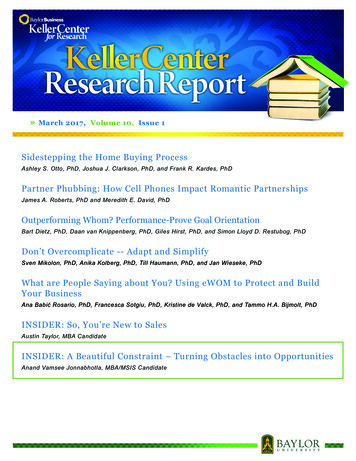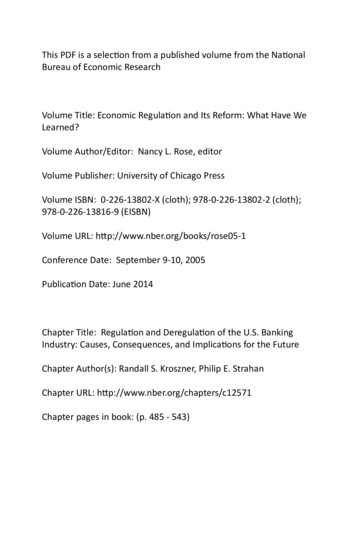
Transcription
»March 2017, Volume 10, Issue 1Sidestepping the Home Buying ProcessAshley S. Otto, PhD, Joshua J. Clarkson, PhD, and Frank R. Kardes, PhDPartner Phubbing: How Cell Phones Impact Romantic PartnershipsJames A. Roberts, PhD and Meredith E. David, PhDOutperforming Whom? Performance-Prove Goal OrientationBart Dietz, PhD, Daan van Knippenberg, PhD, Giles Hirst, PhD, and Simon Lloyd D. Restubog, PhDDon’t Overcomplicate -- Adapt and SimplifySven Mikolon, PhD, Anika Kolberg, PhD, Till Haumann, PhD, and Jan Wieseke, PhDWhat are People Saying about You? Using eWOM to Protect and BuildYour BusinessAna Babić Rosario, PhD, Francesca Sotgiu, PhD, Kristine de Valck, PhD, and Tammo H.A. Bijmolt, PhDINSIDER: So, You’re New to SalesAustin Taylor, MBA CandidateINSIDER: A Beautiful Constraint – Turning Obstacles into OpportunitiesAnand Vamsee Jonnabhotla, MBA/MSIS Candidate
INSIDER: A Beautiful Constraint – Turning Obstaclesinto OpportunitiesAnand Vamsee Jonnabhotla, MBA/MSIS CandidateDo your best Jagger is a famous internet meme today. Sir Michael Phillip Jagger, the manbehind this meme, shot to fame overnight for his performance in a space about the size of a table.Jagger’s success stems from a combination of desire and restriction, which helped him developthe unique Jagger moves. Mick Jagger saw an opportunity in an obstacle and realized the powerof leveraging a beautiful constraint!In the book, A Beautiful Constraint, theauthors, Adam Morgan and Mark Barden,take us through a series of real-worldexamples that show how constraints canpositively impact a project and, in turn, helpdevelop successful sustainable solutions. Weare no longer living in a world with abundantresources. The rate at which we are depletingour resources surely poses challenges. Fromthe budget constraints that drove Google tostart with a simple and easy-to-use userinterface to the challenges of integratingindustries in the world market to support theUnilever’s sustainability initiative, constraintshelp people understand how beautifully theycan aid in progress.A world of too much data, too many choices, too many possibilities and too little time is forcingus to decide what we value. This is true even in the real estate industry. Increased competition,diverse customer preferences, and dependence of technology challenge agents to look for newcustomer attraction methods. To push through such times, we need challengers who haveambitions larger than their resources. That is when constraints appear beautiful.Morgan and Barden begin by defining a constraint, which is a limitation, imposed by outsidecircumstances or by ourselves, that materially affects our ability to do something. The threefundamental factors that help turn constraints into resources are Mindset, Method andMotivation.The following think points put these learnings into practice in the real estate industry:Keller Center Research ReportMarch 2017, Volume 10, Issue 1
INSIDER: A Beautiful Constraint – Turning Obstacles into OpportunitiesTHINK POINT #1: The Victim, Neutralizer and TransformerKeeping one’s ambition high in the face of a succession of constraints is very important for thereal estate agent. Based on the way a person looks at ambitions and constraints, there are threecategories of people:1. Victims: Those who lower their ambition when faced with a constraint2. Neutralizers: Those who refuse to lower their ambition but find a different way todeliver the ambition instead3. Transformers: Those who find a way to use a constraint as an opportunity, evenincreasing their ambition along the wayMany people fall into the victim category in certain situations. However, for agents to besuccessful, they should learn to progress toward becoming transformers. It is always good toidentify a specific goal or task and then impose a new constraint on the task. For example, if thespecific goal is adding new clients, the additional constraint that the agent could impose isacquiring these clients in six months when others look at accomplishing this task in twelvemonths. Increasing one’s constraints will be possible through greater self-awareness as it yieldsvaluable insights into where you might need the most help to progress from one stage to the next.THINK POINT #2: Break Path DependenceOften, real estate agents follow habitual business practices that prevent them from seeingopportunity in a constraint. This path dependence leads into significant and disabling constraintsdetermined by how open-minded and flexible an agent is. The solution to this problem is toidentify the key steps needed to reach a goal. Then, the agent should name his/her naturaltendencies and biases. The next step is to look at the processes and routines that one habituallyuses. Once these habits are identified, the agent can move on to expected sources of solutions.Finally, the process ends at having key performance indicators (KPIs) and measures of success.As an example, consider the time agents must wait for feedback after a prospective customervisits a property. Instead of waiting for the customer to give feedback, a smart real estate agentcan save time by having a mobile app handy, allowing the customer to give immediate feedback.A tacit advantage of such a process is that the immediate opinion of a customer usually reflectshis/her purchasing style and thought process, both of which are helpful for the agent’s futurecommunication.THINK POINT #3: Ask Propelling Questions Followed by Can-IfPropelling questions help in building solutions that address more than just the problem at hand.For example, a real estate company that wishes to address environmental concerns should notKeller Center Research ReportMarch 2017, Volume 10, Issue 1
INSIDER: A Beautiful Constraint – Turning Obstacles into Opportunitieslook solely at investments that help them save energy. It should look at those initiatives that are“bigger” such as building a completely green and sustainable eco-system. Such a thoughtprocess, as the authors believe, will produce amazing results. Propelling questions prompt youtoward a bold ambition linked together with a significant constraint.After posing a propelling question, an agent will need to have both the right tools and the rightattitude to find breakthrough. To do so, the real estate agent’s key challenge is not simply: Howdo we answer this question? Rather, How do we create the controversial climate that gives us thebest possible chance to answer this question? The next step is to brainstorm for solutions. Beginwith We can if rather than with is this possible? This change in approach helps an agent focuson how it might be possible, keeping the oxygen of optimism alive in the process.THINK POINT #4: Creating AbundanceResourceful agents see that if they lack something (time, money, people, ideas) and that scarcityis one of their apparent constraints, it is an opportunity to create abundance elsewhere. One placeto start the search for abundance is by tapping relationships with invested stakeholders. An agentcould utilize the loyalty of existing customers to gain insights into spending habits andpreferences to know the ways to attract new customers. On a larger scale, a real estate agent oreven a company should consider ways of partnering with other industries. For example, a realestate company that wishes to identify new buyers in an area might partner with anotherorganization for leads. In return, the company could offer a discount to the organization’semployees for any new home purchases or leases.THINK POINT #5: Activating EmotionsA personal commitment to remainingambitious is very important to ensurethat projects see successful closure. As asales leader, a real estate professional’srole is to communicate a clear sense ofambition and to elevate the emotionalcommitment to it within the team. As anagent, you must empathize with thecustomer’s need. This empathy will bepossible only by actuating emotions.When a propelling question meets astrong emotion, breakthrough resultsand that is exactly what is needed in this hour of increased competition in the real estate industry.One way to activate the emotions of the buyer is by adopting the method of storytelling (SeeKeller Center Research Report article, “The Power of Storytelling”).Keller Center Research ReportMarch 2017, Volume 10, Issue 1
INSIDER: A Beautiful Constraint – Turning Obstacles into OpportunitiesThe authors emphasize that, in this world of increasing scarcity, constraints can lead to a successor a downfall depending on how an agent looks at them. Promoting a constraint-driven culture isas important as the constraint itself. Once an agent identifies which resources are scarce andwhich ones are abundant, the next strategic move will be to analyze the possible economic valueof any partnerships. Finally, the emotional connection that an agent develops coupled with thetools and techniques mentioned above should aid faster, successful deal closures.Recommended ReadingMorgan, Adam and Mark Barden (2015), A Beautiful Constraint: How to Transform YourLimitations into Advantages and Why It’s Everyone’s Business, John Wiley and Sons Publishers.About the AuthorAnand Vamsee (AV) Jonnabhotla, MBA/MSIS (Dual Degree) CandidateBaylor UniversityAV is a first-year graduate student from India. He holds a B.Tech in Electronics andInstrumentation Engineering. Prior to starting his dual-degree program at Baylor, he worked for4 ½ years with SAP. He also co-founded and managed the startup, DietOnClick in India.Keller Center Research ReportMarch 2017, Volume 10, Issue 1
Keller Center Research ReportBaylor University » Keller Center for Research » Hankamer School of BusinessOne Bear Place #98007 » Waco, TX 76798www.baylor.edu/kellercenter » Keller Center@baylor.eduKeller Center Research Report is a trademark owned by Baylor University. Baylor University. All rights reserved.
INSIDER: A Beautiful Constraint - Turning Obstacles into Opportunities Keller Center Research Report March 2017, Volume 10, Issue 1 The authors emphasize that, in this world of increasing scarcity, constraints can lead to a success or a downfall depending on how an agent looks at them. Promoting a constraint-driven culture is










